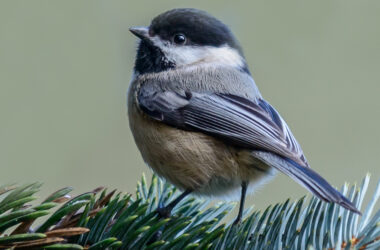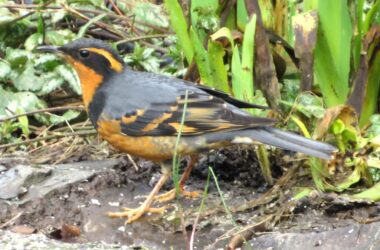International Migratory Bird Day is May 13. The Ankeny National Wildlife Refuge is hosting an event that day at the Nature Center. This is the first spring that Ankeny has been home to a Motus tower that can track certain migrating birds.
Already the Motus sensors have picked up three migrating shorebirds heading to Alaska. Each was a dunlin; each was tagged in California: one near Tomales Bay, two near Colusa. All three flew past and on into Washington State. These birds weigh less than 3 ounces. In constant flight, with perhaps an occasional rest stop, they may travel over 500 hours in a day. Day flight, night flight — the migration must go on.
The Motus tower was a joint project of Salem Audubon Society and U.S. Fish & Wildlife Service. Money came from a grant from Oregon Department of Fish & Wildlife. The tower picks up radio signals from individual, tiny transmitters that can be attached to a bird. Each bird has a unique transmitted identity.
Ankeny is an ideal place to celebrate and learn about the spring and fall migration. Many birds that breed further north will spend weeks or months at Ankeny between September and April. There are thousands of cackling geese down from western Alaska. There are at least ten duck species that populate the Ankeny pools and marshes during the cold months. Smaller birds from colder climates also gather at the refuge — Golden-crowned and fox sparrows are two regulars.
Birds passing through can be abundant during migrations: various shorebirds, turkey vultures, swallows, robins, orange-crowned and yellow-rumped warblers are among those who come and go regularly.
Ankeny also has breeding habitat used by birds who migrate south from here in fall, then return each spring. This includes birds like the rufous hummingbird, western wood-pewee, warbling vireo, swallows, cedar waxwing, Swainson’s thrush, Bullock’s oriole, black-headed grosbeak, common yellowthroat.
The refuge itself was established in 1965. It now encompasses almost 2,800 acres. Its original purpose was to provide wintering habitat for migrating dusky Canada geese and other waterfowl. At that time cackling geese were still considered a subspecies of Canada goose. Cacklers were not recognized as a separate species until 2004. Nowadays the cackling goose is usually the most numerous bird on the refuge during the coldest months.
The World Migratory Bird Day Celebration and Motus unveiling is May 13, 10 a.m. -2 p.m. So come on down. There will be children’s activities, hikes, craft tables, interactive games. This event marks the official grand opening for the Motus tower at Ankeny. Ankeny Hill Nature Center is west of exit 243 off Interstate 5. It is located at 130 Ankeny Hill Road S.E.
Learn more on the refuge website and nature center website.
For information about upcoming Salem Audubon programs and activities, see www.salemaudubon.org, or Salem Audubon’s Facebook page.
Harry Fuller is an Oregon birder and natural history author of “Freeway Birding.” He is a member of the Salem Audubon Society. Contact him at [email protected] or atowhee.blog. His “Some Fascinating Things About Birds” column appears regularly in Salem Reporter.
JUST THE FACTS, FOR SALEM – We report on your community with care and depth, fairness and accuracy. Get local news that matters to you. Subscribe to Salem Reporter. Click I want to subscribe!

Harry Fuller is an Oregon birder and natural history author of three books: “Freeway Birding,” "Great Gray Owls of California, Oregon and Washington," and "San Francisco's Natural History--Sand Dunes to Streetcars." He leads birding trips for the Malheur Field Station. He is a member of the Salem Audubon Society, and leads bird trips locally. Harry has just published a new book, BIrding Harney County.









